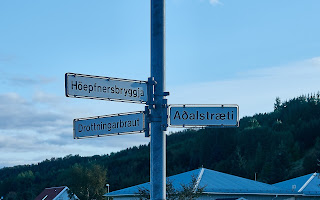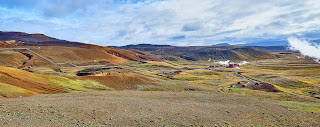As planned, today we returned to the area around the east side of lake Mývatn, stopping once again, briefly, at Goðafoss this time on the side opposite our earlier visit. We concluded that this point of view offered little over what we had already seen so moved on to our destination on the east side of the lake.
Remember to click on any photo to see a larger version.
Just a brief aside here concerning the name, Mývatn, which means ‘Lake of Midges’. Apparently in the summer swarms of these small flies are an unwelcome plague for visitors. Though they can be very annoying (we did have minimal contact with them and they could, in large swarms be very annoying) visitors are asked to keep in mind that they are a vital food source for local wildlife. Recommendation: if they bother you, put on a head net, apply bug repellant generously and hope for a vigorous wind!
Moving on. There are three areas that we intended to see today, the cave, Grjótagja, the volcano Hverfjall and Dimmuborgir’s lava pillars and spikes mentioned in my day 5 post.
 |
Now, writing this almost 3 weeks after returning home makes it difficult to remember times and places precisely. I recall that during the day before we reached our destination we found an interesting short hike which provided some excellent scenic points of view of the area, though it was not on our list of places we had planned to visit today. This is the Höfði peninsula which juts into Mývatn lake on the east side. There is a lovely trail which starts by the parking lot and leads, through a small forest along the lake shore, to these beautiful lava formations and lots of bird-life. The first three images were made on this brief walk.
When we reached our planned destination we opted to take the hike to the cave first and found that the 40 - 45 minute walk took us through the most surprisingly beautiful terrain.

Mixed in with the black lava base were craggy black rocks of various heights amidst amazingly bright coloured flora which included mounds of moss and lichen and what appeared to be stunted birch bushes in addition to other low lying colourful leafy plants.
At some places there was a fairly sharply defined edge of the flora and adjacent large areas which appeared to be completely devoid of the plants covering the terrain we were walking through.
This experience was a complete surprise and for me it was certainly one of the highlights of the day and possibly of the trip.
This experience was a complete surprise and for me it was certainly one of the highlights of the day and possibly of the trip.
 |
| Michael just inside the cave. |
When we reached the cave I found it interesting but a bit anti-climactic after the spectacular landscape we had just come through.
The cave might be familiar to those who follow The Game of Thrones, as some parts of that show were filmed here. Much of the upper portion is formed by huge rocks wedged at a variety of angles against each other leaving large open areas between the rocks. These allow quite a bit of light into the inner area which is partially filled with 45 degree water. When the sun is shining, which it wasn’t, the effect of the sun entering through the open areas apparently provides interesting light inside the cave. According to the signs it was once a popular swimming area but swimming is no longer allowed.
I like the blurred image of Michael. Adds a bit of a (smiley) ghostly effect.
I like the blurred image of Michael. Adds a bit of a (smiley) ghostly effect.
 |
| Volcano Hverfjall |
This huge classic ring crater, dominates the lava fields on eastern side of Mývatn. The residual nearly symmetrical rim rises about 450 meters and is over 1 kilometer across!
The crater apparently appeared about 2700 years ago in a violent eruption.
What remains is composed of loose gravel seemingly barren of plant life though a closer look reveals scattered bits of vegetation which made me smile. It is indicative of the resilience of plant life capable of finding root in the seemingly hostile environment of this pile of gravel.
Travel books say that there is an easy trail up to the rim and, while the trail is not rugged, it is steep and long with the degree of incline increasing the closer you get to the top. In this photo you can, if you look closely at Hverfjall in the distance, get a glimpse of the trail up the side.
I have to say that I had to rest several times on the way to the top but, with encouragement, I did reach it! I don’t think I was the only one taking a bit of a break now and then either. And we didn't notice other identifiable octogenarians among the climbers we saw.
The view from the rim was quite stunning both inside the crater and in the panoramic perspective of the surrounding area outside including areas like Krafla that we had visited a day or so earlier.
The path down was much easier, from a cardiopulmonary stand point, than going up but presented its own challenges for knees and back along with the risk of falling as a result of losing one's balance on unstable rocks. I'm happy to say that I made the climb to the top and the walk down without incident.
The crater apparently appeared about 2700 years ago in a violent eruption.
What remains is composed of loose gravel seemingly barren of plant life though a closer look reveals scattered bits of vegetation which made me smile. It is indicative of the resilience of plant life capable of finding root in the seemingly hostile environment of this pile of gravel.
Travel books say that there is an easy trail up to the rim and, while the trail is not rugged, it is steep and long with the degree of incline increasing the closer you get to the top. In this photo you can, if you look closely at Hverfjall in the distance, get a glimpse of the trail up the side.
I have to say that I had to rest several times on the way to the top but, with encouragement, I did reach it! I don’t think I was the only one taking a bit of a break now and then either. And we didn't notice other identifiable octogenarians among the climbers we saw.
 |
| To get the sense of height, note the vehicle on the road below |
The path down was much easier, from a cardiopulmonary stand point, than going up but presented its own challenges for knees and back along with the risk of falling as a result of losing one's balance on unstable rocks. I'm happy to say that I made the climb to the top and the walk down without incident.
 |
| Remember the geothermal power plant? See it over there? |
From here we drove to nearby Dimmuborgir (literally, Dark Castles) which, along with Grjótagja and the volcano, Hverfjall, where we had just visited, is part of the eastern Mývatn lakeside hike. We originally planned to hike to each of the places but it was a lot of ground to cover during the time available so driving seemed the better travel choice.
Dimmuborgir is a huge area of unusual large lava pillars and crags. It is believed to have been formed around 2000 years ago when a lake of lava from nearby volcanoes formed over a marsh or lake. It is said that hot lava heated the water to boiling pushing water through the molten lava and cooling it to form, over time, the pillars and varied forms of lava rock seen in this area today.
I have a lot of photos of this fascinating area but I think these two give a pretty good idea of what we saw there.
I have a lot of photos of this fascinating area but I think these two give a pretty good idea of what we saw there.
So, it is the end of our last day before the drive back to Keflavik airport and the 5 hour flight to Toronto.
And, as it was our last day, we decided to have dinner at the restaurant said by some locals to be the best restaurant in Akureyri. And, it may well be the best as we found both the food and the ambiance to be excellent and the best we experienced in Akureyri!
Because of the long drive and the need to catch a flight, we passed many potentially excellent photo opportunities, giving in only once, on route to Keflavik.
Our drive to Keflavik took us through Borgarnes - remember Borgarnes? It’s the place where I left my Algarve baseball cap in the restaurant. In spite of the time pressure to get to the airport, Michael wheeled into the parking lot at the restaurant, I went in, retrieved my cap, and we drove on!
When we reached the rental car return at the Keflavik airport we found… well, that’s a story to be forgotten.
Finally, I must tell you that when I went through security at the airport, I forgot to pick up my computer from the little grey tray, so, sadly, left it in the Keflavik airport. But the story has a happy ending! The computer was recovered by the security folks and they returned it to me, safe and sound with all the photos that I have been able to include in these blog posts! My sincere thanks to those who secured my computer, packed it up and sent it to me. To them, I’m very grateful!






















































